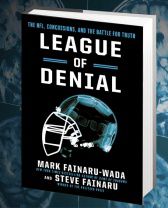For most football fans, the jaw-dropping hits that leave players face down on the turf are part of the reason we love the sport so dearly. I myself am an avid football fan, and will admit that I have jumped off the couch in hysterics more than once after a big hit.
However, I have recently found that I’m not as excited about big hits as I used to be. In fact, they now leave me with a bad taste in my mouth.

Surprisingly, this ugly feeling was caused by two Redwood alumni: brothers and co-authors of League of Denial: The NFL, Concussions, and the Battle for Truth, Mark Fainaru-Wada and Steve Fainaru. The book is groundbreaking and shaming in many aspects, setting the bar high for future journalistic nonfiction writing.
The book focuses on the growing concussion crisis in the NFL and the long-term, sometimes life-altering, impacts that repeated brain injuries have had on former players. It also attacks the NFL for its denial of the role football played in these injuries.
The story starts off in the football mecca of Pittsburgh, following the story of tough-nosed future NFL Hall of Fame Pittsburgh Steelers center Mike “Iron Mike” Webster.
Webster grew up in the working class town of Tomahawk, Wisconsin, where he dealt with unprecedented losses and tough luck. The beginning of the book’s first section, titled Discovery, deals with how Webster’s fear of failure drove his incredible work ethic, leading him to participate in an amazing 5,871 consecutive plays during one six-year stretch of his career.
The book then takes a dark turn, as the second half of Discovery follows Webster’s fall from grace, in which his mental state rapidly deteriorates from what the book presumes to be brain damage from repeated blows to the head. Webster’s friends attempt to save the man who formerly epitomized the blue-collar city of Pittsburgh from himself. These attempts eventually fail, as Webster dies of what is initially thought to be heart failure at only 50 years old.
However, Webster’s death sets off a search to discover if this was truly Webster’s death, a search that requires one important piece of Webster’s body: his brain.
It is in-depth stories like these that keep League of Denial engaging.
It would easy enough to write the facts as they are, in a blunt and uninteresting way, but Fainaru-Wada and Fainaru’s lively writing style make the story of the NFL’s mounting concussion crisis more like a novel than a dry piece of nonfiction.

Their writing style has improved since their last collaboration in the 2006 nonfiction book Game of Shadows, which follows the story of the Barry Bonds steroid scandal. Where Game of Shadows felt like a simple recitation of facts, League of Denial feels more polished and concise.
The end of the book acknowledges that the NFL has has tried to improve the safety of playing football, taking some measures to prevent concussions and head injuries. This balances out the rest of the book, which attacks the NFL’s handling and sometimes even failure to acknowledge its wrongdoings with regards to treatment of possibly concussed players.
I can say with authority that I no longer watch football games, no matter what level, with an eye toward big hits. The rush I used to get when I watched one player hurl his body toward another with the intention of knocking his helmet off is no longer there. The Fainaru brothers’ new book forces its readers to rethink the inherent brutality of the sport that comes with the start of a new fall season.
If you can get through the necessary factuality that comes with a book of this caliber, this is a book that will change the way that any football fan or player will view the way the sport is played. Nonetheless, if you read this book, you’ll never see the bone-crunching hits that are inherently packaged with football the same way ever again.






